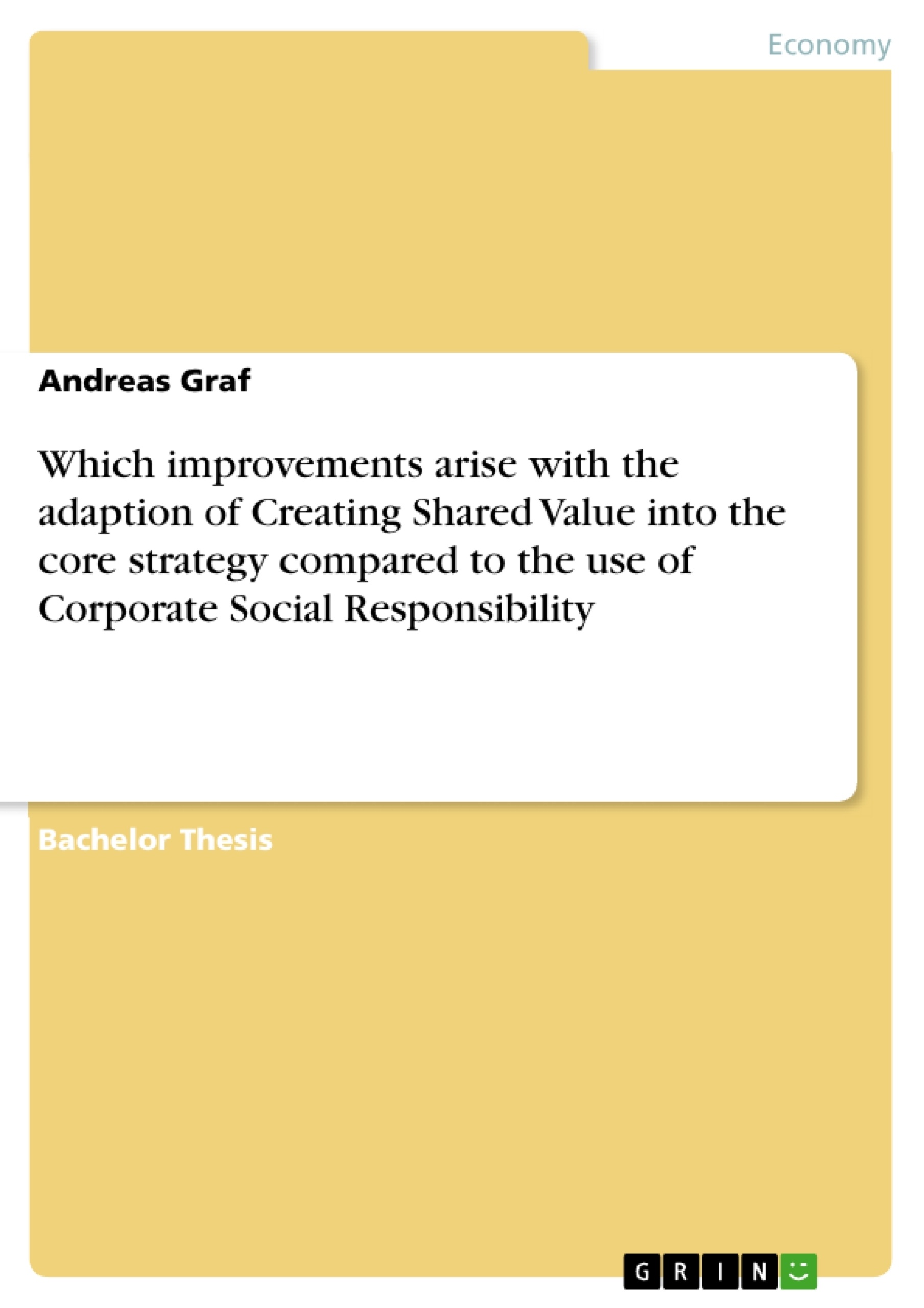In this thesis the author strives to find out if the Shared Value approach will help to improve the sustainability of a company in comparison to the Corporate Social Responsibility approach significantly. First the Anglo-American approach, called Corporate Citizenship (CC), regarding its elements and supplemented by examples of companies, will be discussed.
Afterwards the European approach of CSR, will be analyzed based on the latest definition issued in 2011 by the European Commission. In the next chapter, the Shared Value approach by Porter and Kramer will be described.
Each concept will be substantiated by company examples. Finally, the CSV approach will be compared with the CSR approach. Thereby the author will show the improvements as well as the challenges a company faces if it introduces the CSV approach into its corporate strategy.
Inhaltsverzeichnis (Table of Contents)
- INTRODUCTION
- CORPORATE SOCIAL RESPONSIBILITY
- Corporate Giving.
- Social Sponsorship..
- Cause-Related Marketing.
- Corporate Foundations..
- Corporate Volunteering.
- Social Commissioning.
- Public Private Partnership.
- Social Lobbying....
- Venture Philanthropy (VP).
- CSR ACCORDING TO EUROPEAN STANDARDS.
- Definition
- The Environment..
- Community Involvement and Development
- Labor practices.
- Human Rights.....
- Consumer Issues
- Fair operating practices......
- Organizational Governance....
- CREATING SHARED VALUE.
- Development...
- Definition
- Reconceiving Products and Markets
- Redefining Productivity in the Value Chain: General Information........
- Enabling Local Cluster Development: General Information
- COMPARISON OF CSR AND CSV APPROACHES
- POSITIVE IMPACTS AND ADVANTAGES FOR THE COMPANY
- Positive Impacts and Advantages for the Company in General.
- Positive Impacts and Advantages by Reconceiving Products and Markets ............
- Positive Impacts and Advantages by Redefining Productivity in the Value Chain
- Positive Impacts and Advantages by Enabling Local Cluster Development
- POSITIVE IMPACTS AND ADVANTAGES FOR SOCIETY: IMPROVEMENT OF THE LIVING STANDARD.
- Fair Distribution of Profits.
- Development of New Clusters.
- CSV is More as a Guideline.
- Focus on Needs Instead of Sales Figures.
- POSITIVE IMPACTS AND ADVANTAGES FOR THE ENVIRONMENT.
- Responsible Use of Resources....
- Environmentally Friendly Creation of Value Chains
- CHALLENGES AND DISADVANTAGES FOR THE COMPANY.
- Acceptance by Shareholders.
- Change in the Corporate Culture
- Change in the Remuneration System
- Resistance to Change.
- Modifications in the Hiring Process.
- Laws and Regulation..
- Local Conditions.
- Uneconomical Business
- CONCLUSION ...........
Zielsetzung und Themenschwerpunkte (Objectives and Key Themes)
This bachelor thesis aims to explore the benefits and drawbacks of integrating the Creating Shared Value (CSV) approach into a company's core strategy compared to utilizing Corporate Social Responsibility (CSR). The study examines the potential improvements arising from the adoption of CSV, specifically focusing on its impact on the company, society, and the environment. It also delves into the challenges and disadvantages associated with implementing CSV.
- Comparison of CSR and CSV approaches
- Positive impacts and advantages of CSV for the company
- Positive impacts and advantages of CSV for society
- Positive impacts and advantages of CSV for the environment
- Challenges and disadvantages of implementing CSV
Zusammenfassung der Kapitel (Chapter Summaries)
The introduction sets the stage by highlighting the importance of addressing corporate misconduct and fostering a sustainable economy. It introduces the concepts of 'Compliance' and 'Corporate Social Responsibility' (CSR), emphasizing their role in ensuring ethical business practices. Chapter 2 delves into the concept of CSR, exploring its various forms and defining it according to European standards. The chapter examines key aspects of CSR, including environmental considerations, community involvement, labor practices, human rights, consumer issues, fair operating practices, and organizational governance. Chapter 3 introduces the concept of Creating Shared Value (CSV), outlining its development, definition, and key principles. This chapter explores how CSV can be implemented through reimagining products and markets, redefining productivity in the value chain, and enabling local cluster development. Chapter 4 analyzes the positive impacts and advantages of CSV for the company, society, and the environment. It also addresses the challenges and disadvantages associated with implementing CSV, such as acceptance by shareholders, cultural changes, and resistance to change.
Schlüsselwörter (Keywords)
The core focus of this thesis lies in the comparison of Corporate Social Responsibility (CSR) and Creating Shared Value (CSV) approaches. It delves into the impacts and advantages of CSV for companies, society, and the environment. Key themes include responsible business practices, ethical behavior, sustainable development, stakeholder engagement, and the evolution of corporate social responsibility. This analysis considers the practical challenges and disadvantages associated with implementing CSV within a company's core strategy, highlighting areas such as shareholder acceptance, cultural adjustments, and resistance to change.
- Quote paper
- Andreas Graf (Author), 2016, Which improvements arise with the adaption of Creating Shared Value into the core strategy compared to the use of Corporate Social Responsibility, Munich, GRIN Verlag, https://www.grin.com/document/338724



